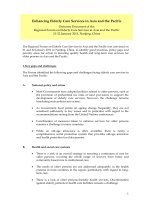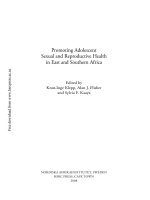Carrying Location Objects in RADIUS and Diameter draft-ietf-geopriv-radius-lo-24. ppt
Bạn đang xem bản rút gọn của tài liệu. Xem và tải ngay bản đầy đủ của tài liệu tại đây (172.13 KB, 62 trang )
GEOPRIV H. Tschofenig, Ed.
Internet-Draft Nokia Siemens Networks
Intended status: Standards Track F. Adrangi
Expires: November 8, 2009 Intel
M. Jones
A. Lior
Bridgewater
B. Aboba
Microsoft Corporation
May 7, 2009
Carrying Location Objects in RADIUS and Diameter
draft-ietf-geopriv-radius-lo-24.txt
Status of this Memo
This Internet-Draft is submitted to IETF in full conformance with the
provisions of BCP 78 and BCP 79.
Internet-Drafts are working documents of the Internet Engineering
Task Force (IETF), its areas, and its working groups. Note that
other groups may also distribute working documents as Internet-
Drafts.
Internet-Drafts are draft documents valid for a maximum of six months
and may be updated, replaced, or obsoleted by other documents at any
time. It is inappropriate to use Internet-Drafts as reference
material or to cite them other than as "work in progress."
The list of current Internet-Drafts can be accessed at
The list of Internet-Draft Shadow Directories can be accessed at
This Internet-Draft will expire on November 8, 2009.
Copyright Notice
Copyright (c) 2009 IETF Trust and the persons identified as the
document authors. All rights reserved.
This document is subject to BCP 78 and the IETF Trust's Legal
Provisions Relating to IETF Documents in effect on the date of
publication of this document (
Please review these documents carefully, as they describe your rights
and restrictions with respect to this document.
Tschofenig, et al. Expires November 8, 2009 [Page 1]
Internet-Draft Carrying LOs in RADIUS and Diameter May 2009
Abstract
This document describes procedures for conveying access network
ownership and location information based on a civic and geospatial
location format in Remote Authentication Dial In User Service
(RADIUS) and Diameter.
The distribution of location information is a privacy sensitive task.
Dealing with mechanisms to preserve the user's privacy is important
and addressed in this document.
Tschofenig, et al. Expires November 8, 2009 [Page 2]
Internet-Draft Carrying LOs in RADIUS and Diameter May 2009
Table of Contents
1. Introduction . . . . . . . . . . . . . . . . . . . . . . . . . 4
2. Terminology . . . . . . . . . . . . . . . . . . . . . . . . . 5
3. Delivery Methods for Location Information . . . . . . . . . . 6
3.1. Location Delivery based on Out-of-Band Agreements . . . . 6
3.2. Location Delivery based on Initial Request . . . . . . . . 7
3.3. Location Delivery based on Mid-Session Request . . . . . . 8
3.4. Location Delivery in Accounting Messages . . . . . . . . . 12
4. Attributes . . . . . . . . . . . . . . . . . . . . . . . . . . 14
4.1. Operator-Name Attribute . . . . . . . . . . . . . . . . . 14
4.2. Location-Information Attribute . . . . . . . . . . . . . . 17
4.3. Location-Data Attribute . . . . . . . . . . . . . . . . . 19
4.3.1. Civic Location Profile . . . . . . . . . . . . . . . . 20
4.3.2. Geospatial Location Profile . . . . . . . . . . . . . 21
4.4. Basic-Location-Policy-Rules Attribute . . . . . . . . . . 21
4.5. Extended-Location-Policy-Rules Attribute . . . . . . . . . 23
4.6. Location-Capable Attribute . . . . . . . . . . . . . . . . 25
4.7. Requested-Location-Info Attribute . . . . . . . . . . . . 28
5. Table of Attributes . . . . . . . . . . . . . . . . . . . . . 34
6. Diameter RADIUS Interoperability . . . . . . . . . . . . . . . 36
7. Security Considerations . . . . . . . . . . . . . . . . . . . 38
7.1. Communication Security . . . . . . . . . . . . . . . . . . 38
7.2. Privacy Considerations . . . . . . . . . . . . . . . . . . 39
7.2.1. RADIUS Client . . . . . . . . . . . . . . . . . . . . 40
7.2.2. RADIUS Server . . . . . . . . . . . . . . . . . . . . 40
7.2.3. RADIUS Proxy . . . . . . . . . . . . . . . . . . . . . 41
7.3. Identity Information and Location Information . . . . . . 41
8. IANA Considerations . . . . . . . . . . . . . . . . . . . . . 43
8.1. New Registry: Operator Namespace Identifier . . . . . . . 43
8.2. New Registry: Location Profiles . . . . . . . . . . . . . 44
8.3. New Registry: Location-Capable Attribute . . . . . . . . . 45
8.4. New Registry: Entity Types . . . . . . . . . . . . . . . . 46
8.5. New Registry: Privacy Flags . . . . . . . . . . . . . . . 46
8.6. New Registry: Requested-Location-Info Attribute . . . . . 46
9. Acknowledgments . . . . . . . . . . . . . . . . . . . . . . . 48
10. References . . . . . . . . . . . . . . . . . . . . . . . . . . 50
10.1. Normative References . . . . . . . . . . . . . . . . . . . 50
10.2. Informative References . . . . . . . . . . . . . . . . . . 50
Appendix A. Matching with Geopriv Requirements . . . . . . . . . 53
A.1. Distribution of Location Information at the User's
Home Network . . . . . . . . . . . . . . . . . . . . . . . 53
A.2. Distribution of Location Information at the Visited
Network . . . . . . . . . . . . . . . . . . . . . . . . . 54
A.3. Requirements matching . . . . . . . . . . . . . . . . . . 55
Authors' Addresses . . . . . . . . . . . . . . . . . . . . . . . . 61
Tschofenig, et al. Expires November 8, 2009 [Page 3]
Internet-Draft Carrying LOs in RADIUS and Diameter May 2009
1. Introduction
This document defines attributes within RADIUS and Diameter that can
be used to convey location-related information within authentication
and accounting exchanges.
Location information may be useful in a number of scenarios.
Wireless networks (including wireless LAN) are being deployed in
public places such as airports, hotels, shopping malls, and coffee
shops by a diverse set of operators such as cellular network
operators, Wireless Internet Service Providers (WISPs), and fixed
broadband operators. In these situations, the home network may need
to know the location of the user, in order to enable location-aware
billing, location-aware authorization, or other location-aware
services. Location information can also prove useful in other
situations (such as wired networks) where operator network ownership
and location information may be needed by the home network.
In order to preserve user privacy, location information needs to be
protected against unauthorized access and distribution. Requirements
for access to location information are defined in [RFC3693]. The
model includes a Location Generator (LG) that creates location
information, a Location Server (LS) that authorizes access to
location information, a Location Recipient (LR) that requests and
receives information, and a Rule Maker (RM) that provides
authorization policies to the LS which enforces access control
policies on requests to location information. In Appendix A the
requirements for a GEOPRIV Using Protocol are compared to the
functionality provided by this document.
Tschofenig, et al. Expires November 8, 2009 [Page 4]
Internet-Draft Carrying LOs in RADIUS and Diameter May 2009
2. Terminology
The key words "MUST", "MUST NOT", "REQUIRED", "SHALL", "SHALL NOT",
"SHOULD", "SHOULD NOT", "RECOMMENDED", "MAY", and "OPTIONAL" in this
document are to be interpreted as described in [RFC2119].
RADIUS specific terminology is borrowed from [RFC2865] and [RFC2866].
Terminology related to privacy issues, location information and
authorization policy rules is taken from [RFC3693].
Tschofenig, et al. Expires November 8, 2009 [Page 5]
Internet-Draft Carrying LOs in RADIUS and Diameter May 2009
3. Delivery Methods for Location Information
The following exchanges show how location information is conveyed in
RADIUS. In describing the usage scenarios, we assume that privacy
policies allow location to be conveyed in RADIUS; however, as noted
in Section 6 similar exchanges can also take place within Diameter.
Privacy issues are discussed in Section 7.2.
3.1. Location Delivery based on Out-of-Band Agreements
Figure 1 shows an example message flow for delivering location
information during the network access authentication and
authorization procedure. Upon a network authentication request from
an access network client, the Network Access Server (NAS) submits a
RADIUS Access-Request message that contains location information
attributes among other required attributes. In this scenario
location information is attached to the Access-Request message
without an explicit request from the RADIUS server. Note that such
an approach with a prior agreement between the RADIUS client and the
RADIUS server is only applicable in certain environments, such as in
situations where the RADIUS client and server are within the same
administrative domain. The Basic-Location-Policy-Rules Attribute is
populated based on the defaults described in Section 4.4, unless it
has been explicitly configured otherwise.
Tschofenig, et al. Expires November 8, 2009 [Page 6]
Internet-Draft Carrying LOs in RADIUS and Diameter May 2009
+ + + + + +
| | | Network | | RADIUS |
| User | | Access | | Server |
| | | Server | | |
+ + + + + +
| | |
| Authentication phase | |
| begin | |
| >| |
| | |
| | Access-Request |
| | + Location-Information |
| | + Location-Data |
| | + Basic-Location-Policy-Rules|
| | + Operator-Name |
| | >|
| | |
| | Access-Accept |
| |< |
| Authentication | |
| Success | |
|< | |
| | |
Figure 1: Location Delivery based on out-of-band Agreements
3.2. Location Delivery based on Initial Request
If the RADIUS client provides a Location-Capable Attribute in the
Access-Request, then the RADIUS server MAY request the RADIUS client
for location information if it requires that information for
authorization, and location information was not provided in Access-
Request. This exchange is shown in Figure 2. The inclusion of the
Location-Capable Attribute in an Access-Request message indicates
that the NAS is capable of providing location data in response to an
Access-Challenge. The subsequent Access-Challenge message sent from
the RADIUS server to the NAS provides a hint regarding the type of
desired location information attributes. The NAS treats the Basic-
Location-Policy-Rules and Extended-Location-Policy-Rules Attributes
as opaque data (e.g., it echoes these rules provided by the server
within the Access-Challenge back in the Access-Request). In the
shown message flow the location attributes are then provided in the
subsequent Access-Request message. When evaluating this Access-
Request message the authorization procedure at the RADIUS server
might be based on a number of criteria, including the newly defined
attributes listed in Section 4.
Tschofenig, et al. Expires November 8, 2009 [Page 7]
Internet-Draft Carrying LOs in RADIUS and Diameter May 2009
+ + + + + +
| | | Network | | RADIUS |
| User | | Access | | Server |
| | | Server | | |
+ + + + + +
| | |
| Authentication phase | |
| begin | |
| >| |
| | |
| | Access-Request |
| | + Location-Capable |
| | >|
| | |
| | Access-Challenge |
| | + Basic-Location-Policy-Rules |
| | + Extended-Location-Policy-Rules|
| | + Requested-Location-Info |
| |< |
| | |
| | Access-Request |
| | + Location-Information |
| | + Location-Data |
| | + Basic-Location-Policy-Rules |
| | + Extended-Location-Policy-Rules|
| | >|
| | |
: : :
: Multiple Protocol Exchanges to perform :
: Authentication, Key Exchange and Authorization :
: continued :
: : :
| | |
| | Access-Accept |
| |< |
| Authentication | |
| Success | |
|< | |
| | |
Figure 2: Location Delivery based on Initial Request
3.3. Location Delivery based on Mid-Session Request
The on-demand mid-session location delivery method utilizes the
Change of Authorization Request (CoA-Request) message and the CoA-
NAK, defined in [RFC5176]. At any time during the session the
Dynamic Authorization Client MAY send a CoA-Request containing
Tschofenig, et al. Expires November 8, 2009 [Page 8]
Internet-Draft Carrying LOs in RADIUS and Diameter May 2009
session identification attributes to the NAS (i.e., Dynamic
Authorization Server).
In order to enable the on-demand mid-session location delivery
method, the RADIUS server MUST return an instance of the Requested-
Location-Info Attribute with the 'FUTURE_REQUESTS' flag set and
instances of the Basic-Location-Policy-Rules and Extended-Location-
Policy-Rules Attributes in the Access-Accept message for the session.
Upon receipt of a CoA-Request message containing a Service-Type
Attribute with value "Authorize Only" for the same session, the NAS
MUST include location information and echo the previously received
Basic-Location-Policy-Rules and Extended-Location-Policy-Rules
Attributes in the subsequent Access-Request message.
Upon receiving the Access-Request message containing the Service-Type
Attribute with a value of Authorize-Only from the NAS, the RADIUS
server responds with either an Access-Accept or an Access-Reject
message.
The use of dynamic authorization [RFC5176] is necessary when location
information is needed on-demand and cannot be obtained from
accounting information in a timely fashion.
Figure 3 shows the above-described approach graphically.
+ + + + + +
| Dynamic | | Dynamic | |RADIUS|
| Authorization | | Authorization | |Server|
| Server/NAS | | Client | | |
+ + + + + +
| | |
| Access-Request | |
| + Location-Capable | |
| >|
| | |
| Access-Challenge | |
| + Basic-Location-Policy-Rules | |
| + Extended-Location-Policy-Rules | |
| + Requested-Location-Info | |
|< |
| | |
| Access-Request | |
| + Location-Information | |
| + Location-Data | |
| + Basic-Location-Policy-Rules | |
| + Extended-Location-Policy-Rules | |
| >|
Tschofenig, et al. Expires November 8, 2009 [Page 9]
Internet-Draft Carrying LOs in RADIUS and Diameter May 2009
| | |
| | |
: | :
: Multiple Protocol Exchanges to perform :
: Authentication, Key Exchange and Authorization :
: continued | :
: | :
| | |
| | |
| Access-Accept | |
| + Requested-Location-Info | |
(FUTURE_REQUESTS, ) | |
| + Basic-Location-Policy-Rules | |
| + Extended-Location-Policy-Rules | |
|< |
| | |
: : :
: <<Some time later>> : :
: : :
| | |
| CoA + Service-Type "Authorize Only" + State | |
|< | |
| | |
| CoA NAK + Service-Type "Authorize Only" | |
| + State | |
| + Error-Cause "Request Initiated" | |
| >| |
| | |
| Access-Request | |
| + Service-Type "Authorize Only" | |
| + State | |
| + Location-Information | |
| + Location-Data | |
| + Basic-Location-Policy-Rules | |
| + Extended-Location-Policy-Rules | |
| >|
| Access-Accept | |
|< |
| | |
Figure 3: Location Delivery based on CoA with Service-Type 'Authorize
Only'
When the Dynamic Authorization Client wants to change the values of
the requested location information, or set the values of the
requested location information for the first time, it may do so
without triggering a reauthorization. Assuming that the NAS had
previously sent an Access-Request containing a Location-Capable
Tschofenig, et al. Expires November 8, 2009 [Page 10]
Internet-Draft Carrying LOs in RADIUS and Diameter May 2009
Attribute, the DAC can send a CoA-Request to the NAS without a
Service-Type Attribute, but including the NAS Identifiers and Session
identifiers as per [RFC5176] and the Requested-Location-Info, Basic-
Location-Policy-Rules and Extended-Location-Policy-Rules Attributes.
The Requested-Location-Info, Basic-Location-Policy-Rules and
Extended-Location-Policy-Rules Attributes MUST NOT be used for
session identification.
Figure 4 shows this approach graphically.
+ + + + + +
| Dynamic | | Dynamic | |RADIUS|
| Authorization | | Authorization | |Server|
| Server/NAS | | Client | | |
+ + + + + +
| | |
| | |
| Access-Request | |
| + Location-Capable | |
| >|
| | |
| Access-Challenge | |
| + Basic-Location-Policy-Rules | |
| + Extended-Location-Policy-Rules | |
| + Requested-Location-Info | |
|< |
| | |
| Access-Request | |
| + Location-Information | |
| + Location-Data | |
| + Basic-Location-Policy-Rules | |
| + Extended-Location-Policy-Rules | |
| >|
| | |
| | |
: | :
: Multiple Protocol Exchanges to perform :
: Authentication, Key Exchange and Authorization :
: continued | :
: | :
| | |
| | |
| Access-Accept | |
| + Requested-Location-Info | |
| + Basic-Location-Policy-Rules | |
| + Extended-Location-Policy-Rules | |
|< |
Tschofenig, et al. Expires November 8, 2009 [Page 11]
Internet-Draft Carrying LOs in RADIUS and Diameter May 2009
| | |
: : :
: <<Some time later>> : :
: : :
| | |
| CoA | |
| + Requested-Location-Info | |
| + Basic-Location-Policy-Rules | |
| + Extended-Location-Policy-Rules | |
|< | |
| | |
| CoA ACK | |
| >| |
| | |
: : :
: <<Further exchanges later>> : :
: : :
Figure 4: Location Delivery based on CoA
3.4. Location Delivery in Accounting Messages
Location Information may also be reported in accounting messages.
Accounting messages are generated when the session starts, when the
session stops and periodically during the lifetime of the session.
Accounting messages may also be generated when the user roams during
handoff.
Accounting information may be needed by the billing system to
calculate the user's bill. For example, there may be different
tariffs or tax rates applied based on the location.
If the RADIUS server needs to obtain location information in
accounting messages then it needs to include a Requested-Location-
Info Attribute to the Access-Accept message. The Basic-Location-
Policy-Rules and the Extended-Location-Policy-Rules Attributes are to
be echoed in the Accounting-Request if indicated in the Access-
Accept.
Figure 5 shows the message exchange.
Tschofenig, et al. Expires November 8, 2009 [Page 12]
Internet-Draft Carrying LOs in RADIUS and Diameter May 2009
+ + + + + +
| | | Network | | RADIUS |
| User | | Access | | Server |
| | | Server | | |
+ + + + + +
| | |
: : :
: Initial Protocol Interaction :
: (details omitted) :
: : :
| | |
| | Access-Accept |
| | + Requested-Location-Info |
| | + Basic-Location-Policy-Rules |
| | + Extended-Location-Policy-Rules|
| |< |
| Authentication | |
| Success | |
|< | |
| | |
| | Accounting-Request |
| | + Location-Information |
| | + Location-Data |
| | + Basic-Location-Policy-Rules |
| | + Extended-Location-Policy-Rules|
| | >|
| | |
| | Accounting-Response |
| |< |
| | |
Figure 5: Location Delivery in Accounting Messages
Tschofenig, et al. Expires November 8, 2009 [Page 13]
Internet-Draft Carrying LOs in RADIUS and Diameter May 2009
4. Attributes
It is important to note that the location specific parts of the
attributes defined below are not meant to be processed by the RADIUS
server. Instead, a location server specific component used in
combination with the RADIUS server is responsible for receiving,
processing and further distributing location information (in
combination with proper access control and privacy protection). As
such, from a RADIUS server point of view location information is
treated as opaque data.
4.1. Operator-Name Attribute
This attribute carries the operator namespace identifier and the
operator name. The operator name is combined with the namespace
identifier to uniquely identify the owner of an access network. The
value of the Operator-Name is a non-NULL terminated string whose
length MUST NOT exceed 253 bytes.
The Operator-Name Attribute SHOULD be sent in Access-Request, and
Accounting-Request messages where the Acc-Status-Type is set to
Start, Interim, or Stop.
A summary of the Operator-Name Attribute is shown below.
Tschofenig, et al. Expires November 8, 2009 [Page 14]
Internet-Draft Carrying LOs in RADIUS and Diameter May 2009
0 1 2 3
0 1 2 3 4 5 6 7 8 9 0 1 2 3 4 5 6 7 8 9 0 1 2 3 4 5 6 7 8 9 0 1
+-+-+-+-+-+-+-+-+-+-+-+-+-+-+-+-+-+-+-+-+-+-+-+-+-+-+-+-+-+-+-+-+
| Type | Length | Text
+-+-+-+-+-+-+-+-+-+-+-+-+-+-+-+-+-+-+-+-+-+-+-+-+-+-+-+-+-+-+-+-+
| Text (cont.)
+-+-+-+-+-+-+-+-+-+-+-+-+-+-+-+-+-+-+-+-+-+-+-+-+-+-+-+-+-+-+-+-+
Type:
To Be Assigned by IANA - Operator-Name
Length:
>= 4
Text:
The format is shown below. The data type of this field is
string. All fields are transmitted from left to right:
0 1 2 3
0 1 2 3 4 5 6 7 8 9 0 1 2 3 4 5 6 7 8 9 0 1 2 3 4 5 6 7 8 9 0 1
+-+-+-+-+-+-+-+-+-+-+-+-+-+-+-+-+-+-+-+-+-+-+-+-+-+-+-+-+-+-+-+-+
| Namespace ID | Operator-Name
+-+-+-+-+-+-+-+-+-+-+-+-+-+-+-+-+-+-+-+-+-+-+-+-+-+-+-+-+-+-+-+-+
| Operator-Name
+-+-+-+-+-+-+-+-+-+-+-+-+-+-+-+-+-+-+-+-+-+-+-+-+-+-+-+-+-+-+-+-+
Namespace ID:
The value within this field contains the
operator namespace identifier. The Namespace ID value
is encoded in ASCII.
Example: '1' (0x31) for REALM
Operator-Name:
The text field of variable length contains an
Access Network Operator Name.
This field is a RADIUS base data type of Text.
The Namespace ID field provides information about the operator
namespace. This document defines four values for this attribute that
are listed below. Additional namespace identifiers must be
registered with IANA (see Section 8.1) and must be associated with an
organization responsible for managing the namespace.
Tschofenig, et al. Expires November 8, 2009 [Page 15]
Internet-Draft Carrying LOs in RADIUS and Diameter May 2009
TADIG ('0' (0x30)):
This namespace can be used to indicate operator names based on
Transferred Account Data Interchange Group (TADIG) codes, as
defined in [GSM]. TADIG codes are assigned by the TADIG Working
Group within the GSM Association. The TADIG Code consists of two
fields, with a total length of five ASCII characters consisting of
a three-character country code and a two-character alphanumeric
operator (or company) ID.
REALM ('1' (0x31)):
The REALM operator namespace can be used to indicate operator
names based on any registered domain name. Such names are
required to be unique and the rights to use a given realm name are
obtained coincident with acquiring the rights to use a particular
Fully Qualified Domain Name (FQDN). Since this operator is
limited to ASCII, any registered domain name which contains non-
ASCII characters must be converted to ASCII. The Punycode
encoding [RFC3492] is used for this purpose.
E212 ('2' (0x32)):
The E212 namespace can be used to indicate operator names based on
the Mobile Country Code (MCC) and Mobile Network Code (MNC)
defined in [ITU212]. The MCC/MCC values are assigned by the
Telecommunications Standardization Bureau (TSB) within the ITU-T
and designated administrators in different countries. The E212
value consists of three ASCII digits containing the MCC, followed
by two or three ASCII digits containing the MNC.
ICC ('3' (0x33)):
The ICC namespace can be used to indicate operator names based on
International Telecommunication Union (ITU) Carrier Codes (ICC)
defined in [ITU1400]. ICC values are assigned by national
regulatory authorities and are coordinated by the
Telecommunication Standardization Bureau (TSB) within the ITU
Telecommunication Standardization Sector (ITU-T). When using the
ICC namespace, the attribute consists of three uppercase ASCII
characters containing a three-letter alphabetic country code, as
defined in [ISO], followed by one to six uppercase alphanumeric
ASCII characters containing the ICC itself.
Tschofenig, et al. Expires November 8, 2009 [Page 16]
Internet-Draft Carrying LOs in RADIUS and Diameter May 2009
4.2. Location-Information Attribute
The Location-Information Attribute MAY be sent in Access-Request and
in Accounting-Request messages. For the Accounting-Request message
the Acc-Status-Type may be set to Start, Interim or Stop.
The Location-Information Attribute provides meta-data about the
location information, such as sighting time, time-to-live, location
determination method, etc.
The format is shown below.
0 1 2 3
0 1 2 3 4 5 6 7 8 9 0 1 2 3 4 5 6 7 8 9 0 1 2 3 4 5 6 7 8 9 0 1
+-+-+-+-+-+-+-+-+-+-+-+-+-+-+-+-+-+-+-+-+-+-+-+-+-+-+-+-+-+-+-+-+
| Type | Length | String
+-+-+-+-+-+-+-+-+-+-+-+-+-+-+-+-+-+-+-+-+-+-+-+-+-+-+-+-+-+-+-+-+
| String (cont.)
+-+-+-+-+-+-+-+-+-+-+-+-+-+-+-+-+-+-+-+-+-+-+-+-+-+-+-+-+-+-+-+-+
Type:
To Be Assigned by IANA - Location-Information
Length:
>= 23
String:
The format is shown below. The data type of this field is
string. All fields are transmitted from left to right:
0 1 2 3
0 1 2 3 4 5 6 7 8 9 0 1 2 3 4 5 6 7 8 9 0 1 2 3 4 5 6 7 8 9 0 1
+-+-+-+-+-+-+-+-+-+-+-+-+-+-+-+-+-+-+-+-+-+-+-+-+-+-+-+-+-+-+-+-+
| Index | Code | Entity |
+-+-+-+-+-+-+-+-+-+-+-+-+-+-+-+-+-+-+-+-+-+-+-+-+-+-+-+-+-+-+-+-+
| Sighting Time ~
+-+-+-+-+-+-+-+-+-+-+-+-+-+-+-+-+-+-+-+-+-+-+-+-+-+-+-+-+-+-+-+-+
| Sighting Time |
+-+-+-+-+-+-+-+-+-+-+-+-+-+-+-+-+-+-+-+-+-+-+-+-+-+-+-+-+-+-+-+-+
| Time-to-Live
+-+-+-+-+-+-+-+-+-+-+-+-+-+-+-+-+-+-+-+-+-+-+-+-+-+-+-+-+-+-+-+-+
| Time-to-Live |
+-+-+-+-+-+-+-+-+-+-+-+-+-+-+-+-+-+-+-+-+-+-+-+-+-+-+-+-+-+-+-+-+
| Method
Tschofenig, et al. Expires November 8, 2009 [Page 17]
Internet-Draft Carrying LOs in RADIUS and Diameter May 2009
+-+-+-+-+-+-+-+-+-+-+-+-+-+-+-+-+-+-+-+-+-+-+-+-+-+-+-+-+-+-+-+-+
Index (16 bits):
The 16-bit unsigned integer value allows this attribute to provide
information relating to the information included in the Location-
Data Attribute to which it refers (via the Index).
Code (8 bits):
This field indicates the content of the location profile carried
in the Location-Data Attribute. Two profiles are defined in this
document, namely one civic location profile (see Section 4.3.1)
that uses value (0) and a geospatial location profile (see
Section 4.3.2) that uses the value (1).
Entity (8 bits):
This field encodes which location this attribute refers to as an
unsigned 8-bit integer value. Location information can refer to
different entities. This document registers two entity values,
namely:
Value (0) describes the location of the user's client device
Value (1) describes the location of the RADIUS client
The registry used for these values is established by this
document, see Section 8.4.
Sighting Time (64 bits)
This field indicates when the Location Information was accurate.
The data type of this field is a string and and the content is
expressed in the 64 bit Network Time Protocol (NTP) timestamp
format [RFC1305].
Time-to-Live (64 bits):
This field gives a hint until when location information should be
considered current. The data type of this field is a string and
the content is expressed in the 64 bit Network Time Protocol (NTP)
timestamp format [RFC1305]. Note that the time-to-live field is
different than Retention Expires field used in the Basic-Location-
Policy-Rules Attribute, see Section 4.4. Retention expires
Tschofenig, et al. Expires November 8, 2009 [Page 18]
Internet-Draft Carrying LOs in RADIUS and Diameter May 2009
indicates the time the recipient is no longer permitted to possess
the location information.
Method (variable):
Describes the way that the location information was determined.
This field MUST contain the value of exactly one IANA-registered
'method' token [RFC4119].
The length of the Location-Information Attribute MUST NOT exceed 253
octets.
4.3. Location-Data Attribute
The Location-Data Attribute MAY be sent in Access-Request and in
Accounting-Request messages. For the Accounting-Request message the
Acc-Status-Type may be set to Start, Interim or Stop.
The format is shown below.
Tschofenig, et al. Expires November 8, 2009 [Page 19]
Internet-Draft Carrying LOs in RADIUS and Diameter May 2009
0 1 2 3
0 1 2 3 4 5 6 7 8 9 0 1 2 3 4 5 6 7 8 9 0 1 2 3 4 5 6 7 8 9 0 1
+-+-+-+-+-+-+-+-+-+-+-+-+-+-+-+-+-+-+-+-+-+-+-+-+-+-+-+-+-+-+-+-+
| Type | Length | String
+-+-+-+-+-+-+-+-+-+-+-+-+-+-+-+-+-+-+-+-+-+-+-+-+-+-+-+-+-+-+-+-+
| String (cont.)
+-+-+-+-+-+-+-+-+-+-+-+-+-+-+-+-+-+-+-+-+-+-+-+-+-+-+-+-+-+-+-+-+
Type:
To Be Assigned by IANA - Location-Data
Length:
>= 5
String:
The format is shown below. The data type of this field is
string. All fields are transmitted from left to right:
0 1 2 3
0 1 2 3 4 5 6 7 8 9 0 1 2 3 4 5 6 7 8 9 0 1 2 3 4 5 6 7 8 9 0 1
+-+-+-+-+-+-+-+-+-+-+-+-+-+-+-+-+-+-+-+-+-+-+-+-+-+-+-+-+-+-+-+-+
| Index | Location
+-+-+-+-+-+-+-+-+-+-+-+-+-+-+-+-+-+-+-+-+-+-+-+-+-+-+-+-+-+-+-+-+
| Location
+-+-+-+-+-+-+-+-+-+-+-+-+-+-+-+-+-+-+-+-+-+-+-+-+-+-+-+-+-+-+-+-+
Index (16 bits):
The 16-bit unsigned integer value allows to associate
the Location-Data Attribute with the
Location-Information Attributes.
Location (variable):
The format of the location data depends on the location
profile. This document defines two location profiles.
Details of the location profiles is described below.
4.3.1. Civic Location Profile
Civic location is a popular way to describe the location of an
entity. This section defines the civic location information profile
corresponding to the value (0) indicated in the Code field of the
Location-Information Attribute. The location format is based on the
encoding format defined in Section 3.1 of [RFC4776] whereby the first
Tschofenig, et al. Expires November 8, 2009 [Page 20]
Internet-Draft Carrying LOs in RADIUS and Diameter May 2009
3 octets (i.e., the code for this DHCP option, the length of the DHCP
option, and the 'what' element are not included) are not put into the
Location field of the above-described RADIUS Location-Data Attribute.
4.3.2. Geospatial Location Profile
This section defines the geospatial location information profile
corresponding to the value (1) indicated in the Code field of the
Location-Information Attribute. Geospatial location information is
encoded as an opaque object whereby the format is reused from the
Section 2 of RFC 3825 Location Configuration Information (LCI) format
[RFC3825] starting with the third octet (i.e., the code for the DHCP
option and the length field is not included).
4.4. Basic-Location-Policy-Rules Attribute
The Basic-Location-Policy-Rules Attribute MAY be sent in an Access-
Request, Access-Accept, an Access-Challenge, a Change-of-
Authorization and in an Accounting-Request message.
Policy rules control the distribution of location information. The
obligation with respect to understanding and processing of the Basic-
Location-Policy-Rules Attribute for RADIUS clients is to utilize a
default value of Basic-Location-Policy-Rules unless explicitly
configured otherwise, and also for clients to echo the Basic-
Location-Policy-Rules Attribute that they receive from a server. As
a default, the note-well field does not carry a pointer to human
readable privacy policies, the retransmission-allowed is set to zero
(0), i.e., further distribution is not allowed, and the retention-
expires field is set to 24 hours.
With regard to authorization policies this document reuses work done
in [RFC4119] and encodes them in a non-XML format. Two fields
('sighting time' and 'time-to-live') are additionally included in the
Location-Information Attribute to conform to the GEOPRIV requirements
[RFC3693], Section 2.7.
The format of the Basic-Location-Policy-Rules Attribute is shown
below.
Tschofenig, et al. Expires November 8, 2009 [Page 21]
Internet-Draft Carrying LOs in RADIUS and Diameter May 2009
0 1 2 3
0 1 2 3 4 5 6 7 8 9 0 1 2 3 4 5 6 7 8 9 0 1 2 3 4 5 6 7 8 9 0 1
+-+-+-+-+-+-+-+-+-+-+-+-+-+-+-+-+-+-+-+-+-+-+-+-+-+-+-+-+-+-+-+-+
| Type | Length | String
+-+-+-+-+-+-+-+-+-+-+-+-+-+-+-+-+-+-+-+-+-+-+-+-+-+-+-+-+-+-+-+-+
| String (cont.)
+-+-+-+-+-+-+-+-+-+-+-+-+-+-+-+-+-+-+-+-+-+-+-+-+-+-+-+-+-+-+-+-+
Type:
To Be Assigned by IANA - Basic-Location-Policy-Rules
Length:
>= 12
String:
The format is shown below. The data type of this field is
string. All fields are transmitted from left to right:
0 1 2 3
0 1 2 3 4 5 6 7 8 9 0 1 2 3 4 5 6 7 8 9 0 1 2 3 4 5 6 7 8 9 0 1
+-+-+-+-+-+-+-+-+-+-+-+-+-+-+-+-+-+-+-+-+-+-+-+-+-+-+-+-+-+-+-+-+
| Flags | Retention Expires
+-+-+-+-+-+-+-+-+-+-+-+-+-+-+-+-+-+-+-+-+-+-+-+-+-+-+-+-+-+-+-+-+
| Retention Expires
+-+-+-+-+-+-+-+-+-+-+-+-+-+-+-+-+-+-+-+-+-+-+-+-+-+-+-+-+-+-+-+-+
| Retention Expires | Note Well
+-+-+-+-+-+-+-+-+-+-+-+-+-+-+-+-+-+-+-+-+-+-+-+-+-+-+-+-+-+-+-+-+
| Note Well
+-+-+-+-+-+-+-+-+-+-+-+-+-+-+-+-+-+-+-+-+-+-+-+-+-+-+-+-+-+-+-+-+
This document reuses fields of the RFC 4119 [RFC4119] 'usage-rules'
element. These fields have the following meaning:
Flags (16 bits):
The Flags field is a bit mask and only the first bit (R) is
defined in this document and corresponds to the retransmission-
allowed field:
Tschofenig, et al. Expires November 8, 2009 [Page 22]
Internet-Draft Carrying LOs in RADIUS and Diameter May 2009
0 1
0 1 2 3 4 5 6 7 8 9 0 1 2 3 4 5
+-+-+-+-+-+-+-+-+-+-+-+-+-+-+-+-+
|R|o o o o o o o o o o o o o o o|
+-+-+-+-+-+-+-+-+-+-+-+-+-+-+-+-+
R = retransmission-allowed
o = reserved.
All reserved bits MUST be zero. When the value of this field the
retransmission-allowed field is set to zero (0), then the
recipient of this Location Object is not permitted to share the
enclosed location information, or the object as a whole, with
other parties. The value of '1' allows to share the location
information with other parties by considering the extended policy
rules.
Retention Expires (64 bits):
This field specifies an absolute date at which time the Recipient
is no longer permitted to possess the location information. The
data type of this field is a string and the format is a 64 bit NTP
timestamp [RFC1305].
Note Well (variable):
This field contains a URI that points to human readable privacy
instructions. The data type of this field is string. This field
is useful when location information is distributed to third party
entities, which can include humans in a location based service.
RADIUS entities are not supposed to process this field.
Whenever a Location Object leaves the RADIUS eco-system the URI in
the note-well attribute MUST be expanded to the human readable
text. For example, when the Location Object is transferred to a
SIP based environment then the human readable text is placed into
the 'note-well' element of the 'usage-rules' element contained in
the PIDF-LO document (see [RFC4119]). The note-well field may be
empty.
4.5. Extended-Location-Policy-Rules Attribute
The Extended-Location-Policy-Rules Attribute MAY be sent in an
Access-Request, an Access-Accept, an Access-Challenge, an Access-
Reject, an Change-of-Authorization and in an Accounting-Request
message.
Tschofenig, et al. Expires November 8, 2009 [Page 23]
Internet-Draft Carrying LOs in RADIUS and Diameter May 2009
The ruleset reference field of this attribute is of variable length.
It contains a URI that indicates where the richer ruleset can be
found. This URI SHOULD use the HTTPS URI scheme. As a deviation
from [RFC4119] this field only contains a reference and does not
carry an attached extended rule set. This modification is motivated
by the size limitations imposed by RADIUS.
Policy rules control the distribution of location information and, as
with the Basic Policy Rules Attribute the obligation with respect to
understanding and processing of the Extended-Location-Policy-Rules
Attribute for RADIUS clients is when they are explicitly configured
to attach the URI, and also for clients to echo the Extended-
Location-Policy-Rules Attribute that they receive from a server.
There is no expectation that RADIUS clients will need to retrieve
data at the URL specified in the attribute and to parse the XML
policies.
The format of the Extended-Location-Policy-Rules Attribute is shown
below.
Tschofenig, et al. Expires November 8, 2009 [Page 24]
Internet-Draft Carrying LOs in RADIUS and Diameter May 2009
0 1 2 3
0 1 2 3 4 5 6 7 8 9 0 1 2 3 4 5 6 7 8 9 0 1 2 3 4 5 6 7 8 9 0 1
+-+-+-+-+-+-+-+-+-+-+-+-+-+-+-+-+-+-+-+-+-+-+-+-+-+-+-+-+-+-+-+-+
| Type | Length | String
+-+-+-+-+-+-+-+-+-+-+-+-+-+-+-+-+-+-+-+-+-+-+-+-+-+-+-+-+-+-+-+-+
| String (cont.)
+-+-+-+-+-+-+-+-+-+-+-+-+-+-+-+-+-+-+-+-+-+-+-+-+-+-+-+-+-+-+-+-+
Type:
To Be Assigned by IANA - Extended-Location-Policy-Rules
Length:
>= 3
String:
This field is at least two octets in length, and the format
is shown below. The data type of this field is string.
The fields are transmitted from left to right:
0 1 2 3
0 1 2 3 4 5 6 7 8 9 0 1 2 3 4 5 6 7 8 9 0 1 2 3 4 5 6 7 8 9 0 1
+-+-+-+-+-+-+-+-+-+-+-+-+-+-+-+-+-+-+-+-+-+-+-+-+-+-+-+-+-+-+-+-+
| Ruleset Reference
+-+-+-+-+-+-+-+-+-+-+-+-+-+-+-+-+-+-+-+-+-+-+-+-+-+-+-+-+-+-+-+-+
Ruleset Reference:
This field contains a URI that points to the policy rules.
4.6. Location-Capable Attribute
The Location-Capable Attribute allows a NAS (or client function of a
proxy server) to indicate support for the functionality specified in
this document. The Location-Capable Attribute with the value for
'Location Capable' MUST be sent with the Access-Request messages, if
the NAS supports the functionality described in this document and is
capable of sending location information. A RADIUS server MUST NOT
challenge for location information unless the Location-Capable
Attribute has been sent to it.
Tschofenig, et al. Expires November 8, 2009 [Page 25]









